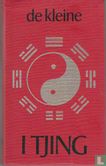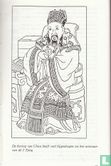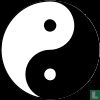With an introduction by Alphons van der Burg
Taoism or Daoism (pronounced [dew-is-me]), is a Chinese philosophical and religious movement. The texts Tao Te Ching (Daodejing) and Zhuangzi form the basis of Taoism, they were written in the fourth and third centuries before our era. Taoism developed in parallel with Confucianism and Buddhism. These three movements together form the basis for neo-Confucianism (see also: List of religions).
Literally Tao means (to go away / purposefully), which can also be recognized in the Chinese character for Tao.
Tao Te Ching:
Tao Te Ching (Book of the Way and the Power) is a collection of 81 short texts. Laozi is considered the author, although the collection of texts probably did not have one author, but grew gradually.
The lyrics are about how to act correctly in life and they explain our existence. They are seen as a guideline for good leadership. These texts were first passed down orally, arranged in a rhythm, arranged, adapted, provided with commentary and finally written down around 300 BC. The book consists of two parts, the most common order of the parts is probably not the authentic order. In an old manuscript (The four writings of the Yellow Emperor) the reverse order has been found. (in the Mawangduigraf)
Philosophy:
The word Tao means 'the Way' and is the core concept of Taoism, from which it also takes its name. Tao is the indivisible and indescribable principle from which everything flows.
Tai Ji (or Tai Chi) means "the highest extreme" and is the infinite and fundamental principle of evolution and self-organization. It is the unity of Yin and Yang and with it all of existence.
Yin and Yang are the universal antagonists, complementary qualities of existence. For example, cold (Yin) and heat (Yang) cannot exist without each other. Other examples of Yin-Yang are water-fire, moon-sun, earth-sun, moon-earth, and woman-man. What is striking is that earth is yang in relation to the moon (and the moon yin) but in relation to the sun yin (and the sun yang). Yin-yang are therefore relative or relative concepts and it is therefore not the case that something is yin or yang in an absolute sense, the concepts are always related. What is dark, moist, passive, cloudy, cold, soft and feminine is considered Yin and what is light, dry, active, clear, warm, hard and masculine, as Yang.
Wuxing is the harmonic system of the five elements: water, fire, earth, metal, wood. The system has a nourishing (producing) cycle (Sheng): wood? fire ? soil ? metal? water? wood; and a control cycle (Ke): wood? soil ? water? fire ? metal? wood. The two cycles together form a pentagon with a five-pointed star in it. They are also often depicted together as a circle with a five-pointed star. The circle is the Sheng cycle, the star represents the Ke cycle.
Wu Wei is doing nothing or letting go. A Taoist does not try to resist the course of things, but to go along with it spontaneously.
Literature:
Ransdorp, René, Wandering with Zhuang Zi - familiarizing yourself with Taoist philosophy, Budel (Damon) 2007, ISBN 9789055738250
This text has been translated automatically from Dutch
Click here for the original text
Met een inleiding door Alphons van der Burg
Het taoïsme of daoïsme (uitgesproken als [daauw-is-me]), is een Chinese filosofische en religieuze stroming. De teksten Tao Te Ching (Daodejing) en Zhuangzi vormen de basis van het taoïsme, ze zijn op schrift gesteld in de vierde en derde eeuw vóór onze tijdrekening. Het taoïsme heeft zich ontwikkeld parallel met het confucianisme en boeddhisme. Deze drie stromingen vormen gezamenlijk de basis voor het neo-confucianisme (zie ook: Lijst van religies).
Letterlijk betekent Tao (weg/doelgericht-gaan) hetgeen ook in het Chinese karakter voor Tao valt te herkennen.
Tao Te Ching:
Tao Te Ching (Boek van de Weg en de Kracht) is een bundel van 81 korte teksten. Laozi wordt beschouwd als de auteur, alhoewel de verzameling teksten waarschijnlijk niet één auteur heeft gehad, maar geleidelijk is gegroeid.
De teksten gaan over hoe juist te handelen in het leven en ze geven een uitleg over ons bestaan. Ze worden wel beschouwd als richtlijn voor goed leiderschap. Deze teksten zijn eerst mondeling overgeleverd, in een ritme ondergebracht, geordend, aangepast, van commentaar voorzien en uiteindelijk rond 300 vóór Christus opgeschreven. Het boek bestaat uit twee delen, de meest gebruikelijke volgorde van de delen is waarschijnlijk niet de authentieke volgorde. In een oud handschrift (De vier geschriften van de Gele Keizer) is de omgekeerde volgorde gevonden. (in het Mawangduigraf)
Filosofie:
Het woord Tao betekent 'de Weg' en vormt het kernbegrip van het taoïsme, waaraan het ook zijn naam ontleent. Tao is het ondeelbare en onbeschrijfbare principe, waaruit alles voortvloeit.
Tai Ji (of Tai Chi) betekent 'het hoogste uiterste' en is het oneindige en fundamentele principe van evolutie en zelf-organisatie. Het is de eenheid van Yin en Yang en daarmee het hele bestaan.
Yin en Yang zijn de universele antagonisten, elkaar aanvullende kwaliteiten van het bestaan. Zo kunnen kou (Yin) en warmte (Yang) niet zonder elkaar bestaan. Andere voorbeelden van Yin-Yang zijn water-vuur, maan-zon, aarde-zon, maan-aarde en vrouw-man. Wat opvalt is dat aarde in betrekking tot de maan yang is (en de maan yin) maar in betrekking tot de zon yin (en de zon yang). Yin-yang zijn dus relatieve of betrekkelijke begrippen en het is dus niet zo dat iets yin is of yang is in absolute zin, de begrippen staan altijd in een betrekking. Wat donker, vochtig, passief, troebel, koud, zacht en vrouwelijk is, wordt beschouwd als Yin en wat licht, droog, actief, helder, warm, hard en mannelijk is, als Yang.
Wuxing is het harmonische systeem van de vijf elementen: water, vuur, aarde, metaal, hout. Het systeem heeft een voedende (voortbrengende) cyclus (Sheng): hout ? vuur ? aarde ? metaal ? water ? hout; en een controle cyclus (Ke): hout ? aarde ? water ? vuur ? metaal ? hout. De twee cycli vormen samen een pentagoon met een vijfpuntige ster erin. Ze worden ook vaak samen afgebeeld als cirkel met een vijfpuntige ster. De cirkel is de Sheng-cyclus, de ster geeft de Ke-cyclus weer.
Wu Wei is het niets doen of loslaten. Een taoïst probeert zich niet te verzetten tegen de loop der dingen, maar daar spontaan in mee te gaan.
Literatuur:
Ransdorp, René, Zwervend met Zhuang Zi - wegwijs in de taoïstische filosofie, Budel (Damon) 2007, ISBN 9789055738250











